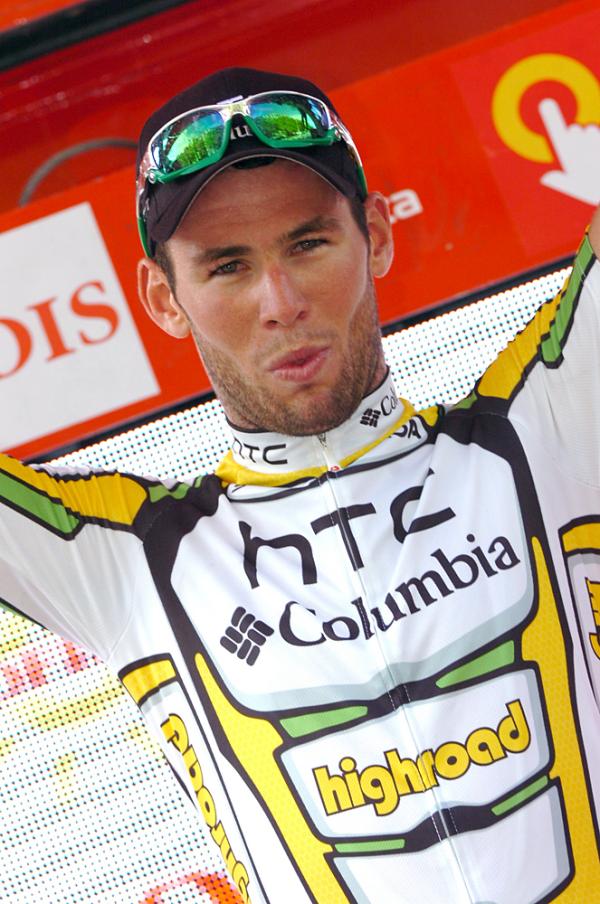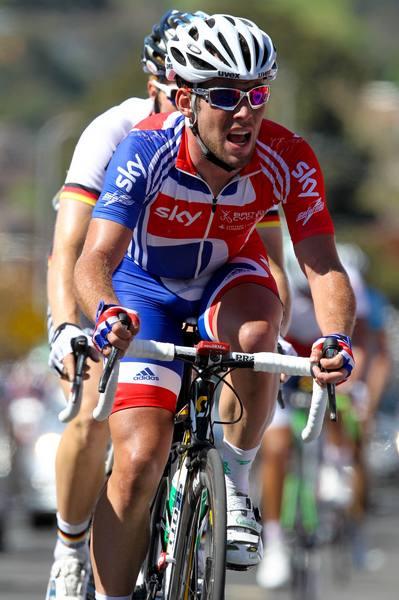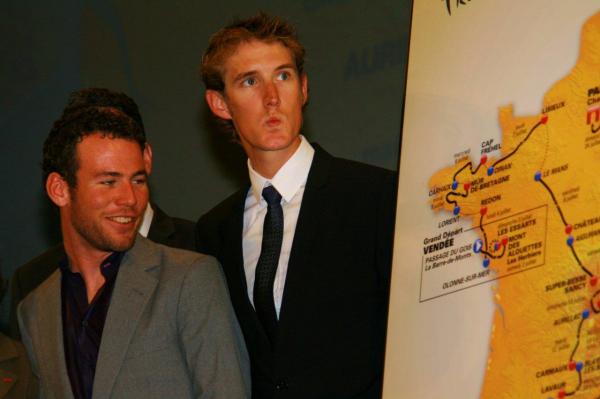There’s something about Marky
The once unbeatable, unbreakable partnership between HTC-Columbia boss Bob Stapleton and his star sprinter Mark Cavendish appears to be showing signs of strain. Anthony Tan examines how it happened, why it happened, and what the future may hold.



On January 18, a day before André Greipel embarked on what would turn out to be another successful Tour Down Under campaign, winning three stages en route to a second overall victory, HTC-Columbia team owner Bob Stapleton was still thinking about his ‘other’ sprinter, Mark Cavendish.
“Oh, I couldn’t be more enthusiastic about Mark Cavendish,” Stapleton said in Adelaide, Australia, when asked if he believed his star sprinter – so clearly the world’s best in 2009 – would be cut above his rivals again this year. “And it’s not just his athletic ability – it’s his attitude and his desire to improve himself. I think he’s the complete package, and I think you’re going to see a potentially even better Cavendish this year. I think he was a level above [in 2009]; many people commented on that, recognised that, and he’s certainly only going to get better.”
At first, it didn’t look that way.
Compared to the previous year, where Cavendish had already tasted victory at the Tour of Qatar, winning two stages, the Tour of California (two stages again), Tirreno-Adriatico (one stage), and every sprinter’s dream, Milan-San Remo, it wasn’t until March 23, the second stage of the Volta a Catalunya, that the then 24-year-old notched his first season victory.
Vanity saw Cavendish get his teeth straightened over the winter, which subsequently led to a tooth infection and left him unable to train for a fortnight. But once he started training, then racing, something appeared to be missing. Clearly, pressure had been building on the Manxman, who, whenever he raced, ostensibly had the entire team at his disposal.
Missing guidance?
Some say it was the absence of George Hincapie. The veteran American, who spent the 2008 and 2009 seasons alongside Cavendish, often roomed with the prodigy and thus became somewhat of a father figure, and was as instrumental in his victories as Mark Renshaw, often described as the best lead-out man in the world. At the close of the 2009 season, Hincapie announced that he would ride for a smaller outfit, BMC Racing; a move that HTC-Columbia sport director Rolf Aldag said gave him “the biggest headache over the winter” – a roundabout way of saying just how irreplaceable Hincapie was.
Get The Leadout Newsletter
The latest race content, interviews, features, reviews and expert buying guides, direct to your inbox!
“Mark and I still talk several times a week, we still have a great relationship, and he understands my decision to come to Team BMC,” Hincapie said at the start of the year. “I’m sure Mark will miss me but I think he’ll continue to be successful.”
“George really has two dimensions,” said Stapleton. “One is the quiet, calm leadership he brings, his depth of experience that makes every rider comfortable and [gives the feeling that] we can win, no matter what; and then what he brings athletically. I think we can fill the gap athletically – I think we are filling the gap – but you can never replace the experience, the charisma, the quiet leadership that a George Hincapie brings.”
In April at the Tour de Romandie in Switzerland, the angst became obvious when Cavendish took only his second stage win of the season, giving “reporters who don’t know shit about bike racing” the one-fingered salute as he crossed the line in Fleurier. At the behest of Stapleton, perhaps his greatest fan, he was told to pack his suitcase and thrown off the race.
Again in Switzerland, Cavendish fell foul of public sentiment six weeks later, this time at the Tour de Suisse, the final precursor to the Tour de France. At the end of the fourth stage, he appeared to stray off his line and brought down Cervélo’s Heinrich Haussler among others, and was criticised for his bullyboy riding style.
Then at La Grande Boucle, it took him the best part of a week to find his winning ways again, and when he finally did on the fifth stage, the pent up emotion expunged itself as he wept uncontrollably on the podium, shedding tears that would not abate. Four more victories, including what he called “the holy grail for sprinters”, success on the Champs-Élysées, and it appeared that Cav was back in the good books. As he always does – some say to the point of broken-record repetition – he praised his team, saying that within HTC-Columbia, there exists a bond like no other.
Or is there?
The departed
Including Hincapie, in the past two seasons, Stapleton has seen – or will soon see – more than a dozen riders leave for other teams.
And they’re not just anybody, either. By year’s end, Michael Barry, Marcus Burghardt, Edvald Boasson Hagen, André Greipel, Adam Hansen, Gregory Henderson, George Hincapie, Kim Kirchen, Thomas Lövkvist, Maxime Monfort, Morris Possoni, Vicente Reynes and Michael Rogers will have left the squad.
The eight who departed at the close of 2009 – Barry, Burghardt, Boasson Hagen, Henderson, Hincapie, Kirchen, Lövkvist, Possoni – were replaced by 10 newcomers, mostly neo-professionals or inexperienced riders. Asked how the most successful team in terms of wins amassed refocuses to replicate its success, Stapleton said at January’s Tour Down Under: “I think the first thing we did was look immediately at what we were doing, starting with re-loading our roster, trading in some 30-somethings for some 20-somethings, looking hard at the roles we need in the team, and to make sure we were bringing in enough new athletes that had growth potential.”
For the record, half of those who left were 27 or younger at the time; Burghardt, at 26 years and seven months, was the eldest.
Granted, it is part of the natural cycle of professional cycling that riders come and go, and a minority few of those who left or are set to leave possibly did not perform as hoped. But to see so many big names leaving – does that say something about a team essentially built around one sprinter, and the sustainability of such a model? Not since the heady days of Alessandro Petacchi or Tom Boonen (who is more of a Classics rider who can sprint well) has there been a team who has afforded one rider such overwhelming luxury.
It seems less of an issue when a team is built around a general classification contender, such as a Lance Armstrong or an Alberto Contador or a Cadel Evans.
But with the 2009 world champion it took a change of teams before Evans, who left Lotto for BMC Racing, was satisfied, acrimoniously parting ways with the Belgian squad soon after he took the rainbow jersey in Mendrisio, Switzerland.
“He’s number one in our team – the clear number one in our team,” BMC owner, Andy Rihs, said of Evans at July’s Tour de France. “And we do everything we can to make him successful. When he is successful, logically this relaxes him, because he knows everything is organised from the material down to everything he needs. But if don’t get what you need, maybe everybody gets a little bit angry. And this is not the case here.”
Is the Tour now in Stapleton’s sights?
Back in January, we asked Stapleton if, despite the perennial success of Cavendish in sprint stages, he still harbours ambitions to one day win the Tour. “Well, I think Alberto Contador is going to be extremely difficult to dislodge for the foreseeable future,” he said.
Right now, there’s a strong possibility that Contador – who, on the Tour’s second rest day in Pau, tested positive for trace amounts of weight-loss and muscle-building drug clenbuterol and, according to leaked information, plasticizers commonly used in stored blood bags, indicative of an autologous blood transfusion – may be stripped of his Tour de France title and suspended for up to two years.
In light of this news, has Stapleton had a rethink?
Cavendish, who at a press conference at the Commonwealth Games in Delhi (he finished seventh in the men’s road race behind winner Allan Davis) claimed HTC-Columbia is not offering him a contract extension beyond 2011, as is his wont, and took particular aim at Stapleton. “I’ve got great family, great friends, great team-mates. People around me appreciate when it’s like that. I’m not sure if my team does,” Cavendish said. “Not my team as a whole, but the manager. I’ve not been offered a new contract yet – I don’t know why that is. I’m committed to a contract I signed a few years ago, [but] there’s been no goodwill, no bonuses, nothing. I feel kind of abused for what I’ve achieved.”
Requests for comment by Cyclingnews to HTC-Columbia’s press office went without response from Stapleton.
Cav: “Something is wrong when we don’t have enough sponsors”
Most likely, Stapleton’s simply waiting on his sponsors to renew – and significantly with the exit of Columbia at the end of this year, a new title sponsor to come aboard, along with HTC – before offering Cavendish a contract extension.
“There are a couple of people whose job it is to get new sponsors and it’s frustrating when they can’t and we suffer for it. I’m just frustrated because I’ve been massively underpaid this year and next because for some reason we can’t get more sponsors,” Cavendish told Britain’s Observer newspaper following the Commonwealth Games.
He has a point. Even in today’s post-GFC economic climate, it does appear incongruous that one of the world’s most successful outfits cannot find a major backer when lesser teams have been able to. “We’re the most successful team on the planet and something is wrong when we don't have enough sponsors,” Cavendish said.
Said Stapleton, who genuinely appears to harbour no grudge towards riders who leave his team, accepting the coming and going of athletes is part of the evolutionary cycle of professional team sports: “I think for me, the most rewarding thing is to see athletes come into our program that are wearing our jerseys or moving on to other teams really moving our sport forward. I would love to have, five or ten years from now, a lot of the key athletes from the sport have High Road or HTC-Columbia DNA in them at some place.”
The future
Without Cavendish, he still has Australians Mark Renshaw and Matthew Goss; winners in their own right with the latter poised for stardom and possessing qualities similar to the Manxman albeit not quite as fast though slightly more versatile, as Goss showed with his win at the GP Ouest-France on August 22. And should he concentrate on developing a future Grand Tour winner, he has a few in-waiting: 22-year-old American phenom Tejay Van Garderen and the 25-year-old Velits twins, Martin and Peter; the latter finishing third overall at this year’s Vuelta a España.
Van Garderen, who in his neo-professional year, secured four top-ten overall placings including third overall in the Criterium du Dauphiné as well as a team time trial victory in the opening stage of the Vuelta, said of his season: “I definitely didn’t expect to have all the success I had, but [my time] with the Rabobank Continental squad, I think they developed my pretty well. So I expected the transition to be smooth, but I didn’t expect those kind of results. The third at the Dauphiné was the result that started getting people’s heads turning, I think.”
And the presence of Stapleton as owner, part-financier, and guiding – often uncompromising – force? “Bob’s definitely good for the sport, for sure – he’s definitely supportive of the team.”
“I’d like to be a Grand Tour rider,” said Van Garderen, “but whether I can or not, it’s still yet to be determined. I had always known I was a GC rider. But it’s still questionable whether I’m going to be a GC rider for one-week races or three-week races – I’m still kind of figuring myself out, but I had always known my strength was in stage races. I hope to, one day, pull it all together for three weeks.”
It seems Stapleton would also like that very much – sooner rather than later.
But for now, it seems he and Cavendish need to sit down and have a face-to-face chat together before Dave Brailsford at Team Sky gets that chance. With the acquisition of Bradley Wiggins last year, we’ve seen how buying out a rider is simply viewed as part of the process for this rather grandiose James Murdoch-backed venture and how persuasive their lawyers are, who must already be smelling blood.